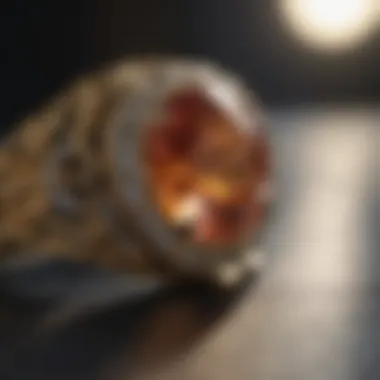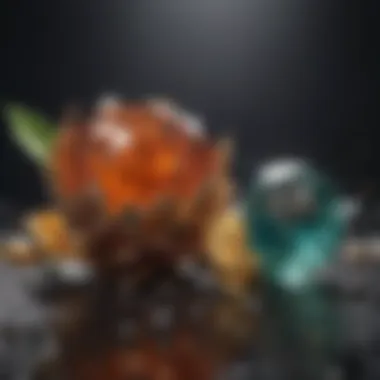Affordable Jewelry Cleaning Solutions Guide


Intro
Cleaning jewelry is an essential aspect of maintenance that often gets overlooked. Over time, dirt and grime accumulate, dulling the shine of gemstones and metals. Regular cleaning ensures not only the aesthetic appeal of these pieces but also their longevity. This guide dives into various affordable solutions for cleaning jewelry, exploring both commercial options and DIY methods. Armed with this knowledge, you will be more equipped to keep your collections in excellent condition.
Gemstone Overview
Definition and Origins
Gemstones are naturally occurring mineral formations that have been cut and polished for use in jewelry. They are formed through geological processes over millions of years. Their origins can typically be traced back to igneous, metamorphic, or sedimentary rocks, each contributing to the unique qualities of the gemstones.
Historical Significance
Throughout history, gemstones have held significant value and meaning. Various cultures regarded gems as symbols of power, health, and protection. For instance, ancient Egyptians adorned themselves with lapis lazuli for its vibrant hue, believing it offered divine protection. This cultural relevance continues today, as many collectors and enthusiasts remain keen to learn about the stories behind their pieces.
Gemstone Properties
Hardness and Durability
The hardness of a gemstone is measured on the Mohs scale, which ranges from 1 to 10. For example, talc is a 1, while diamond, the hardest gem, ranks a 10. Understanding a stone's hardness is crucial when selecting cleaning solutions since softer stones require gentler methods to avoid scratches. Typically, more durable stones can withstand more rigorous cleaning techniques.
"Choosing the right cleaning method based on hardness can prevent damage and extend the life of your gemstone."
Color and Clarity
Color and clarity are central to a gemstone's overall appeal. Color variations arise from the presence of trace elements during formation. Clarity, meanwhile, refers to the presence of internal flaws or inclusions. High clarity typically enhances the stone's value. For cleaning, maintaining color and clarity is vital, as harsh substances can cause discoloration or cloudiness. Regular maintenance helps in preserving these qualities, ensuring the beauty of your jewelry for years to come.
Understanding the Importance of Jewelry Cleaning
Jewelry cleaning is often overlooked, but it plays a crucial role in maintaining the beauty and longevity of treasured pieces. This section will explore why regular cleaning is not merely a grooming task, but an essential practice that impacts both aesthetics and the value of jewelry.
Impact on Aesthetics and Value
Regularly cleaning jewelry can significantly enhance its appearance. Over time, items may accumulate dirt, oil from skin, and other residues that dull their shine. For instance, a simple piece of gold jewelry may lose its luster and look tarnished or dirty. Cleaning restores its original brilliance, making it visually appealing.
Additionally, jewelry cleaning impacts the intrinsic value of items. For collectors and enthusiasts, maintaining gemstone brilliance and metal condition is vital. A well-maintained piece often commands higher resale value than an unkempt one. A customer who understands this will not only enjoy wearing their jewelry but also appreciate its worth in the market.
Different Types of Jewelry Materials
Understanding the properties of different materials is vital. Each type of jewelry requires specific cleaning approaches, making it important to recognize the distinctions between them.
Gold
Gold is frequently chosen for its durability and low reactivity. It does not tarnish, but it can still become dirty from exposure to oils and dirt. This quality makes gold a popular choice because owners do not have to clean it as often as other metals. However, it is essential to note that too much abrasive cleaning can scratch the metal. Gentle methods are generally sufficient and protect its surface.
Silver
Silver jewelry possesses a distinct charm, yet it is prone to tarnishing due to sulfur in the air. Regular cleaning is necessary to prevent buildup. Silver requires a gentle touch; scratching can easily mar its surface. The key advantage of silver is its versatility and affordability, making it accessible for many people. Nevertheless, its susceptibility to tarnish means that owners need to invest time in its upkeep.
Platinum


Platinum is another favored choice, often lauded for its uniqueness and strength. It is incredibly durable and generally resistant to scratches. Platinum jewelry remains untarnished over time, which enhances its appeal. The disadvantage is its cost, as platinum is more expensive than gold or silver. Thus, selecting the right cleaning process that maintains its characteristics without damaging it becomes crucial for owners.
Gemstone-Studded
Cleaning gemstone-set jewelry requires an understanding of the specific types of stones used. While many gemstones are hard and can endure typical cleaning methods, some are more sensitive. For example, opals and pearls require special treatment to avoid damage. Gemstone-studded pieces hold both aesthetic and sentimental value, making proper cleaning essential to preserve that connection while also maintaining visual appeal. Each stone's unique qualities dictate the required approach, and recognizing these factors ensures that owners can protect their investments effectively.
Types of Jewelry Cleaners Available
The significance of selecting the appropriate jewelry cleaner cannot be overstated. It plays a crucial role in preserving the aesthetic integrity and intrinsic value of various types of jewelry. Different cleaning methods yield varying results, and understanding the options available ensures that wearers can maintain their pieces without risking damage. In this section, we will explore the main categories of jewelry cleaners, focusing on both commercial products and DIY solutions. Each option has its unique advantages that can suit any budget or cleaning requirement, thus enabling jewelry enthusiasts to choose wisely.
Commercial Jewelry Cleaners
Commercial jewelry cleaners have evolved to address the need for effective cleaning solutions that are easy to use and often specifically formulated for different materials. They come in various forms, including liquid cleaners, ultrasonic cleaners, and sprays and wipes. This section will delve into each type, highlighting their key characteristics and contributions to jewelry care.
Liquid Cleaners
Liquid cleaners are well-regarded for their accessibility and effectiveness. These solutions are often formulated to tackle tough grime and tarnish on various jewelry materials, making them a popular choice among many enthusiasts. One of the key characteristics of liquid cleaners is their versatility; they can often be used on gold, silver, and platinum without compromising the material.
The unique feature of these cleaners is their ability to dissolve dirt with minimal effort. Users can simply soak their jewelry in the solution or apply it with a soft cloth. However, it is important to check the labels for specific instructions and safety warnings. The main advantage of liquid cleaners is their ease of use, but they can sometimes contain harsh chemicals, which might not be suitable for all jewelry types.
Ultrasonic Cleaners
Ultrasonic cleaners represent a more advanced cleaning method. Utilizing high-frequency sound waves, these devices generate bubbles in the cleaning solution that effectively remove dirt and grime from intricate design areas. The key characteristic of ultrasonic cleaners is their ability to penetrate tiny crevices that standard cleaning methods might miss.
This feature makes them an appealing option. While they can clean multiple pieces of jewelry simultaneously, users must be cautious as some delicate gemstones or certain vintage items may not withstand the sonic waves. Knowledge of the jewelry's composition is essential before using this method. Ultrasonic cleaners are efficient, but their initial cost can be higher compared to other cleaning methods.
Sprays and Wipes
Sprays and wipes are convenient for quick touch-ups and maintenance. They offer the user a straightforward application method without requiring soaking or specialized equipment. The key aspect of sprays and wipes is their portability, making them ideal for on-the-go jewelry cleaning. Whether at an event or traveling, they provide a simple solution to maintain a piece’s shine.
The unique feature of these products is their formulation, often designed for specific types of jewelry. However, their cleaning power may vary, and they may not be suitable for deeply tarnished or heavily soiled items. Overall, sprays and wipes can be beneficial for regular maintenance, but they may not replace thorough cleaning methods needed for extensive buildup.
DIY Jewelry Cleaning Solutions
For those looking to save money or prefer natural cleaning methods, DIY jewelry cleaning solutions present a viable alternative. These recipes often utilize household items that are easy to find and affordable. In this section, we will discuss popular DIY options, focusing on their key attributes and effectiveness in maintaining jewelry integrity.
Baking Soda and Water
Baking soda and water is a classic, economical solution for cleaning jewelry. This method involves creating a paste, which serves as a gentle abrasive that can effectively remove tarnish. The key benefit of this mix is its non-toxic nature, making it safe for various materials such as gold and silver.
Baking soda’s mild alkalinity helps cut through grime without harming the jewelry. A caution to consider is that while this method works well for durable pieces, it might be too abrasive for softer stones. Overall, it’s an excellent choice for those seeking cost-effective cleaning while being gentle on the items.
Vinegar and Dish Soap
A mixture of vinegar and dish soap is another excellent DIY option. The acidity in vinegar cuts through built-up tarnish and grease, while dish soap helps to remove dirt without damaging the jewelry. This combination is particularly beneficial for items that require both antimicrobial properties and deep cleaning.
The unique advantage is that vinegar is widely available and relatively inexpensive. Users should be aware that prolonged exposure to vinegar may not be suitable for all gemstones, especially porous ones. Nonetheless, it is a useful and effective solution for a variety of jewelry cleaning needs.
Alcohol-Based Solutions


Alcohol-based solutions can also provide effective cleaning for jewelry. Primarily used for its disinfectant properties, this method helps remove grease and dirt effectively. The key characteristic is its rapid evaporation, which means that it leaves no residue behind, helping jewelry to shine.
While alcohol can disinfect, care should be taken because it may not be compatible with all types of gemstones or adhesives used in jewelry construction. The advantage of using alcohol is its availability and the minimal effort required for cleaning. However, always ensure compatibility with the specific jewelry before applying it.
By understanding the types of jewelry cleaners available, consumers can make more informed decisions that align with their cleaning preferences and jewelry materials. Choosing the right cleaner not only prolongs the life of the jewelry but also maintains its value and appearance.
Evaluating Effectiveness of Cheap Jewelry Cleaners
Examining the effectiveness of affordable jewelry cleaners is essential for jewelry owners who want to maintain the aesthetic appeal and intrinsic value of their pieces without breaking the bank. Cheap jewelry cleaners can vary widely in quality and effectiveness, which makes it crucial to understand what to look for when selecting these products. Evaluating their effectiveness involves assessing ingredients, cleaning techniques, and safety standards associated with them. By choosing the right cleaner, one can ensure that their jewelry remains in excellent condition while also being cost-effective.
Analyzing Ingredients
When evaluating cheap jewelry cleaners, one of the most important aspects is the composition of the cleaner. Many commercial cleaners contain various chemicals, some of which can be harsh and damaging to certain types of jewelry. For instance, ammonia and bleach are common ingredients in some solutions, but they can tarnish silver or damage gemstone settings. Here are key points to consider:
- Understanding the Role of Ingredients: The primary purpose of any cleaner is to remove dirt and tarnish. Ingredients like surfactants help lift grime, while mild acids can dissolve tarnish without harming the jewelry.
- Common Ingredients in Cheap Cleaners: Look for cleaners that use less aggressive chemicals. Ingredients such as baking soda, vinegar, or citric acid are often gentler and can be as effective without risking damage.
- Label Checks: Always check labels before purchasing. Manufacturers often list key ingredients, which can help in determining the safety and compatibility of the cleaner with your jewelry type.
Ultimately, understanding the ingredients can prevent potential damage to your jewelry, maintaining its look and longevity.
Understanding Safety Standards
Safety in jewelry cleaning should never be overlooked. Many cheap cleaners may not undergo rigorous testing before hitting the market, so it's vital to understand their safety implications. Here are crucial factors to analyze:
- Regulatory Compliance: Check if the cleaner complies with regulatory standards. Products that meet guidelines set forth by health and safety organizations are more likely to be safer for consumer use.
- User Instructions: Manufacturers often include recommended usage instructions on the label. Following these instructions ensures that jewelry is not exposed to harmful practices that could cause damage.
- User Reviews: Researching online reviews from other users can provide insight into a product’s effectiveness and safety. Customers often share their experiences with specific cleaners that can illuminate potential issues or benefits.
"Choosing a cleaner that aligns with safety standards not only protects your jewelry but also your health."
In summary, evaluating the effectiveness of cheap jewelry cleaners involves a careful analysis of ingredients and adherence to safety standards. A thoughtful approach to selecting a cleaner will lead to better care for jewelry, ensuring its shine remains undiminished over time.
Guidelines for Cleaning Specific Types of Jewelry
Jewelry holds significant value, both sentimental and monetary. Proper cleaning and maintenance of each specific type is essential to preserving that value over time. Understanding the unique cleaning needs for various materials prevents damage and maintains the aesthetic brilliance of the items. This section will discuss the appropriate methods for cleaning gold, silver, and gemstone jewelry, ensuring that they remain in excellent condition.
Cleaning Gold Jewelry
Gold jewelry is relatively durable and resistant to tarnishing. However, it can still accumulate dirt and oils from skin contact. To clean gold jewelry, a gentle approach is necessary. Using warm water mixed with a few drops of mild dish soap can effectively refresh gold pieces. Immerse the jewelry for about 15 minutes, then gently scrub with a soft brush to remove any residue. Rinse thoroughly with clean water and dry using a soft cloth. Avoid harsh chemicals which can scratch or dull the gold surface.
Cleaning Silver Jewelry
Silver jewelry is more prone to tarnishing than gold due to its reaction with sulfur in the air. Regular cleaning is vital. A simple method involves using a silver polish specifically designed for jewelry. Apply it with a soft cloth and buff to restore shine. Additionally, a paste made of baking soda and water can be effective for tougher tarnish. Apply the paste, let it sit for a few minutes, then gently scrub and rinse with warm water. Again, drying properly is important to prevent future tarnishing.
Cleaning Gemstone Jewelry
Gemstone jewelry requires careful attention due to the diverse nature of gemstones. Each stone has unique properties and cleaning needs depending on its hardness and sensitivity to chemicals.
Sensitive Stones
Sensitive stones like opals and pearls require a cautious approach. They can be damaged by harsh cleaners or excessive moisture. The ideal method for cleaning sensitive gemstones is to use a damp cloth. Avoid submerging them in water. For light cleaning, use a mild soap solution on a soft, damp cloth, gently wiping the surface. It is essential to keep these stones away from chemicals that can cause discoloration or damage.
Durable Stones


Durable stones, such as diamonds and sapphires, are less sensitive and can handle slightly more aggressive cleaning. They can be soaked in warm soapy water and scrubbed lightly with a soft brush. Rinse them well with water and dry thoroughly. While durable stones are resilient, it’s still wise to avoid chemicals that can cause long-term harm. Proper cleaning practices enhance their shine and prolong their life.
"Regular care and cleaning not only enhance the beauty of your jewelry but also preserve its value over time."
Understanding the specific cleaning needs for different types of jewelry is crucial for their upkeep. The methods discussed here are straightforward and cost-effective, making it easy for anyone to care for their precious items.
Best Practices for Jewelry Maintenance
Maintaining jewelry is crucial not just for its aesthetic appeal but also for its lasting value. Regular attention to your pieces can prevent buildup of dirt and oils, preserving the shine of metals and the brilliance of gemstones. This section explores key practices that every jewelry owner should adopt to ensure their treasured items remain in excellent condition.
Regular Cleaning Schedule
Establishing a regular cleaning schedule is essential for jewelry care. Depending on the frequency of wear, you might want to clean your jewelry weekly, bi-weekly, or monthly. For items that are worn daily, such as rings or bracelets, a weekly clean can prevent significant buildup. Even if the jewelry doesn’t appear dirty, oils from skin can accumulate over time.
Cleaning jewelry regularly helps maintain its appearance and can also help identify issues early, such as loose stones or signs of wear that may require professional attention.
To create this schedule:
- Assess Usage: Different types of jewelry require different care. Consider how often you wear each piece.
- Choose Appropriate Cleaners: Use the appropriate cleaners discussed earlier, ensuring that they suit the material.
- Document Cleaning Sessions: Keeping track with a simple log can help you determine when each piece was last cleaned.
It is important to remember that different materials might react differently to cleaning methods. Thus, using the correct method can prevent damaging your favorites.
Storage Solutions to Prevent Damage
How you store your jewelry can significantly affect its condition over time. Proper storage not only prevents physical damage but also protects pieces from tarnishing and scratching.
Here are some practical storage solutions:
- Individual pouches or boxes: Keeping items separately can prevent scratches. Soft pouches made from fabric are particularly effective for this purpose.
- Anti-tarnish cloths: For silver jewelry, wrapping pieces in cloths treated to inhibit tarnish can extend their shine.
- Use of Divided Trays: A jewelry box with compartments helps organize items and keeps them visible, making it less likely for them to be lost or forgotten.
- Avoiding Humidity: Store jewelry in a dry environment, as humidity can accelerate tarnishing and deterioration.
Proper storage not only keeps jewelry safe but also helps retain its value, making it a key consideration for collectors and enthusiasts alike.
By incorporating these best practices into your routine, you can ensure your jewelry remains beautiful for years to come. Investing time in maintenance reflects your appreciation for these items, whether they are heirlooms or personal collections.
Debunking Myths About Jewelry Cleaning
Understanding the common myths surrounding jewelry cleaning is crucial for maintaining the integrity and longevity of various types of jewelry. Many individuals rely on hearsay rather than factual information, which can lead to damaging practices. Properly debunking these myths helps jewelry owners choose appropriate cleaning methods that will not harm their valuables. In this section, we will focus on two prevalent misconceptions that could potentially impact the effectiveness and safety of jewelry care:
Common Misconceptions
All Cleaners Are Safe
A widespread belief in the jewelry community is that all cleaners marketed for jewelry are safe to use. This notion can be misleading, as not all products are created equal. Some cleaners contain harsh chemicals that can react negatively with specific metals or gemstones. For instance, abrasive cleaners may scratch delicate surfaces or strip away protective coatings on jewelry.
It is vital to assess the components of a cleaner before application. A product labeled as safe for all types of jewelry may not account for sensitive materials, such as certain gemstones or soft metals. Always read the label and ensure that the cleaner is suitable for your specific jewelry type.
The key characteristic of this misconception is its implications for safety. While many cleaners are general-purpose, they can cause harm if misapplied. It is essential to seek products specifically designed for the metals and stones you own, emphasizing tailored solutions.
Frequent Cleaning Is Harmful
Another common myth is that frequent cleaning of jewelry can lead to degradation. While it is necessary to maintain cleanliness, overdoing it can cause wear and damage. Frequent exposure to cleaning agents, especially if they are abrasive or chemically harsh, can erode finishes and potentially dull luster over time.
This myth often stems from misunderstanding what constitutes the right cleaning frequency. Instead of assuming that every wear necessitates immediate cleaning, consider the environment in which the jewelry is worn. For example, everyday exposure to cosmetics, oils, or sweat may warrant more frequent cleaning compared to pieces worn occasionally.
A unique feature of this misconception is its potential psychological impact on collectors. The idea that cleaning too much is harmful may lead to neglect, resulting in a buildup of dirt and tarnish. Therefore, establishing a balanced cleaning routine based on wear and exposure is crucial. Choosing gentle yet effective cleaning methods will support jewelry maintenance without the risk of damage.



